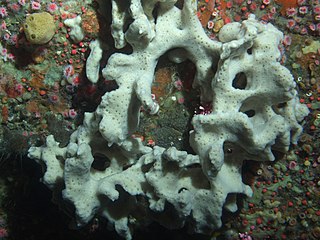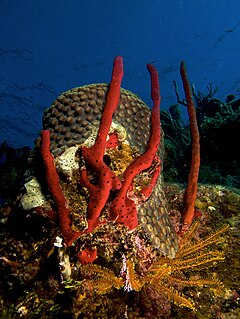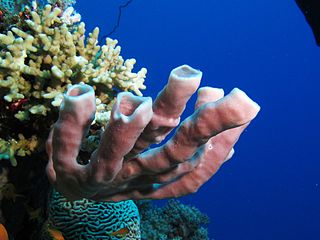| Smenospongia | |
|---|---|
| Scientific classification | |
| Kingdom: | Animalia |
| Phylum: | Porifera |
| Class: | Demospongiae |
| Order: | Dictyoceratida |
| Family: | Thorectidae |
| Subfamily: | Thorectinae |
| Genus: | Smenospongia Wiedenmayer, 1977 |
| Type species | |
| Aplysina aurea Hyatt, 1875 | |
Smenospongia is a genus of demosponges in the family Thorectidae.

Demosponges are the most diverse class in the phylum Porifera. They include 76.2% of all species of sponges with nearly 8,800 species worldwide. They are sponges with a soft body that covers a hard, often massive skeleton made of calcium carbonate, either aragonite or calcite. They are predominantly leuconoid in structure. Their "skeletons" are made of spicules consisting of fibers of the protein spongin, the mineral silica, or both. Where spicules of silica are present, they have a different shape from those in the otherwise similar glass sponges.

Thorectidae is a family of sea sponges in the order Dictyoceratida.
Twelve new species of Korean Smenospongia were described in 2016. [1] As of November 2018 [update] , the World Porifera database accepted the following species of Smenospongia: [2]
- Smenospongia arbuscula Sim, Lee & Kim, 2016
- Smenospongia aurea (Hyatt, 1875)
- Smenospongia cerebriformis (Duchassaing & Michelotti, 1864)
- Smenospongia conulosa Pulitzer-Finali, 1986
- Smenospongia dokdoensis Sim, Lee & Kim, 2016
- Smenospongia duokyeo Sim, Lee & Kim, 2016
- Smenospongia dysodes (de Laubenfels, 1954)
- Smenospongia echina (Laubenfels, 1934)
- Smenospongia flavia Sim, Lee & Kim, 2016
- Smenospongia gageoensis Sim, Lee & Kim, 2016
- Smenospongia musicalis (Duchassaing & Michelotti, 1864)
- Smenospongia nigra Sim, Lee & Kim, 2016
- Smenospongia nuda (Lévi, 1969)
- Smenospongia ramosa Sandes & Pinheiro, 2014
- Smenospongia scalaris Sim, Lee & Kim, 2016
- Smenospongia spinulosa Sim, Lee & Kim, 2016
- Smenospongia varispina Sim, Lee & Kim, 2016
- Smenospongia wiedenmayeri Sim, Lee & Kim, 2016
Smenospongia aurea is a species of sea sponge in the class Demospongiae. The scientific name of the species was first validly published in 1875 by Alpheus Hyatt, as Aplysina aurea.
Smenospongia echina is a species of sea sponge in the class Demospongiae. The scientific name of the species was first validly published in 1934 by Max Walker de Laubenfels, as Polyfibrospongia echina.











